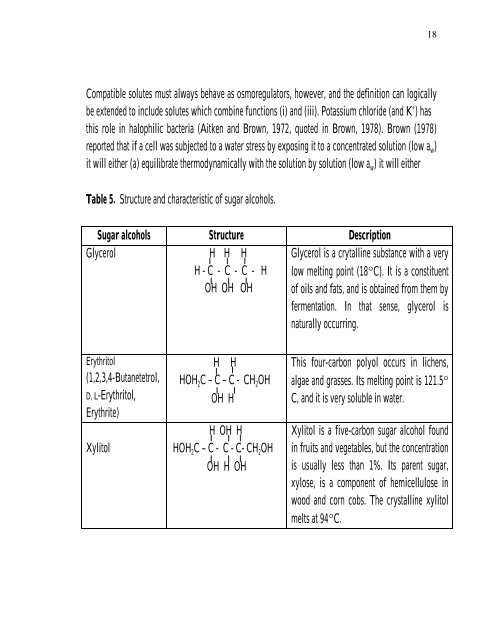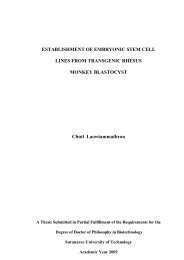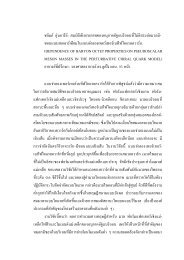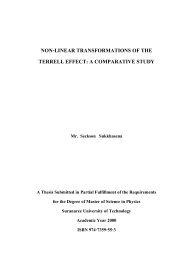- Page 1 and 2: PRODUCTION OF NUTRIENT SOURCES FOR
- Page 3 and 4: PRODUCTION OF NUTRIENT SOURCES FOR
- Page 5 and 6: CHARDCHAI BUROM : PRODUCTION OF NUT
- Page 7 and 8: CONTENTS Page ABSTRACT (THAI)……
- Page 9 and 10: 3.6.1� Determination of the suita
- Page 11 and 12: ���� 17� Glycerol concent
- Page 13 and 14: 40� Time courses of mannitol prod
- Page 15 and 16: 59� Effects of various heat shock
- Page 17 and 18: LIST OF TABLES Table Page ���
- Page 19 and 20: LIST OF ABBREVIATIONS Aw water avai
- Page 21 and 22: CHAPTER I INTRODUCTION For mass cul
- Page 23 and 24: available (Burton, 1965). The molec
- Page 25 and 26: 1.1.1� Carbon metabolism in Rhizo
- Page 27 and 28: strains unable to use the carbon so
- Page 29 and 30: Figure 2. The fructose bisphosphate
- Page 31 and 32: 1.2�Classification of yeasts Mank
- Page 33 and 34: Table 3. (continued). Class Order F
- Page 35 and 36: Ustilaginales (Oberwinkler, 1987).
- Page 37: f Cystofilobasidium has thick-walle
- Page 41 and 42: specific cases, but Brown (1978) pr
- Page 43 and 44: KY 6166 was also studied using larg
- Page 45 and 46: Figure 5. Important pathways of gly
- Page 47 and 48: may be present in different ratios.
- Page 49 and 50: amylase systems of the yeast specie
- Page 51 and 52: Table 7. (continued). EC Recommende
- Page 53 and 54: Table 8. (continued). Species a D.p
- Page 55 and 56: Table 9. (continued). Cell product
- Page 57 and 58: 2.1.3 Equipment and other materials
- Page 59 and 60: Spotted either the supernatant of c
- Page 61 and 62: amylase action, the actual reaction
- Page 63 and 64: A) Determination of the suitable an
- Page 65 and 66: B) Salt-stress conditions Fifty mil
- Page 67 and 68: 2.2.8 Cultivation of Bradyrhizobium
- Page 69 and 70: The cultured medium of yeast. Quant
- Page 71 and 72: intervals for accumulation of gas i
- Page 73 and 74: CHAPTER III RESULTS AND DISCUSSION
- Page 75 and 76: Glycerol Xylitol Glucose Mannitol S
- Page 77 and 78: Glycerol Xylitol Glucose Mannitol S
- Page 79 and 80: Table 10. Primary screening of glyc
- Page 81 and 82: Table 10. (continued). No. Isolate
- Page 83 and 84: Glycerol in cell lysate (g/l) A Gly
- Page 85 and 86: average were 4-10 g of glycerol per
- Page 87 and 88: were isolated from fresh fruits, Ma
- Page 89 and 90:
�third day of incubation (Figure
- Page 91 and 92:
Reducing sugars (g/l) Reducing suga
- Page 93 and 94:
These results indicated that the co
- Page 95 and 96:
3.6.1 Determination of the suitable
- Page 97 and 98:
g/l 1.8 1.6 1.4 1.2 1.0 0.8 0.6 0.4
- Page 99 and 100:
Reducing sugars (g/l) 8 6 4 2 0 0 1
- Page 101 and 102:
Reducing sugars (g/l) 4.0 3.5 3.0 2
- Page 103 and 104:
g/l 1.4 1.2 1.0 0.8 0.6 0.4 0.2 0.0
- Page 105 and 106:
g/l g/l g/l 1.5 1.0 0.5 0.0 1.2 1.0
- Page 107 and 108:
Starch fermentation was conducted i
- Page 109 and 110:
g/l g/l 7 6 5 4 3 2 1 0 8 6 4 2 0 0
- Page 111 and 112:
g/l g/l 8 6 4 2 0 8 6 4 2 0 1 2 3 4
- Page 113 and 114:
g/l g/l 8 6 4 2 0 8 6 4 2 0 0 1 1 2
- Page 115 and 116:
g/l g/l 1.6 1.4 1.2 1.0 0.8 0.6 0.4
- Page 117 and 118:
g/l g/l 1.6 1.4 1.2 1.0 0.8 0.6 0.4
- Page 119 and 120:
The results showed that amounts var
- Page 121 and 122:
g/l g/l 4.0 3.5 3.0 2.5 2.0 1.5 1.0
- Page 123 and 124:
��� fermentation, but the inc
- Page 125 and 126:
g/l g/l 2.0 1.6 1.2 0.8 0.4 0.0 3.2
- Page 127 and 128:
g/l g/l 1.2 1.0 0.8 0.6 0.4 0.2 0.0
- Page 129 and 130:
��� intracellularly a decreas
- Page 131 and 132:
g/l g/l 5.0 4.0 3.0 2.0 1.0 0.0 2.5
- Page 133 and 134:
g/l g/l 2 1.8 1.6 1.4 1.2 1 0.8 0.6
- Page 135 and 136:
g/L 7 6 5 4 3 2 1 0 1 2 3 4 5 6 7 0
- Page 137 and 138:
g/l 8 7 6 5 4 3 2 1 0 1 2 3 4 5 6 7
- Page 139 and 140:
��� effected by heat shock po
- Page 141 and 142:
Table 15. The comparison of media f
- Page 143 and 144:
Table 17. Growth of Bradyrhizobium
- Page 145 and 146:
��� Rhizobium (Stowers, 1985;
- Page 147 and 148:
��� 3.9 Identification of yea
- Page 149 and 150:
KAY1 PIY2 PUY4 Y69 LIY2 COY1 FAY2 C
- Page 151 and 152:
��� assimilations were observ
- Page 153 and 154:
Table 20. (continued). Yeast strain
- Page 155 and 156:
Table 20. (continued). 15. Pichia k
- Page 157 and 158:
��� 3.9.5 Ascospore formation
- Page 159 and 160:
(a) (b) (c ) (d) (e) ��� Figu
- Page 161 and 162:
(a) (b) (c) (d) (e) (f) ��� F
- Page 163 and 164:
(c) (a) ��� Figure 72. Cell m
- Page 165 and 166:
��� Metshnikowia (Pitt and Mi
- Page 167 and 168:
CHAPTER IV CONCLUSION This study ex
- Page 169 and 170:
only a low capital investment. Ther
- Page 171 and 172:
��� Barnett, J. A., Payne, R.
- Page 173 and 174:
��� De Mot, R., and Verachter
- Page 175 and 176:
��� Jennings, D. H. (1995). T
- Page 177 and 178:
��� Lie, T. A., Muilenbury M.
- Page 179 and 180:
��� Onishi, H., and Suzuki, T
- Page 181 and 182:
��� Sinclair, N. A., and Stok
- Page 183 and 184:
��� Van Rossum, D., Schuurman
- Page 185 and 186:
��� Young, J. P. W., and Hauk
- Page 187 and 188:
Acetone Methanol Solvent for mobile
- Page 189 and 190:
� 300 µg/ml, 200 µg/ml, and 100
- Page 191 and 192:
Soluble Starch 20.0 g Distilled wat
- Page 193 and 194:
13.�Nitrate broth KNO 3 1.0 g Glu
- Page 195 and 196:
If the sample had been diluted befo
- Page 197 and 198:
Table 1D. (continued). Source of ye
- Page 199 and 200:
Table 1D. (continued). Source of ye
- Page 201 and 202:
Table 1D. (continued). Source of ye
- Page 203 and 204:
Table 1D. (continued). Source of ye
- Page 205 and 206:
Table 1D. (continued). Source of ye
- Page 207 and 208:
Table 1D. (continued). Source of ye
- Page 209 and 210:
Table 1D. (continued). Source of ye
- Page 212 and 213:
E. Additional figures Abs 540 nm (a
- Page 214 and 215:
Abs 580 nm 1.4 1.2 1 0.8 0.6 0.4 0.
- Page 216 and 217:
Figure 7E. Calibration curves for H
- Page 218 and 219:
Figure 9E. Example of HPLC chromato
- Page 220:
Cell/mL 1.0E+09 8.0E+08 6.0E+08 4.0






